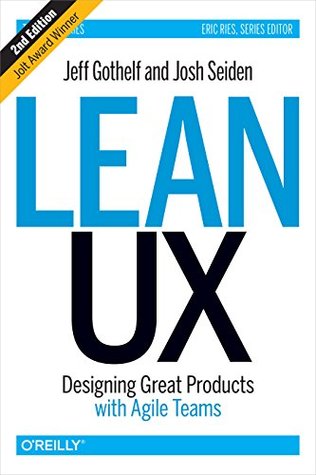More on this book
Community
Kindle Notes & Highlights
by
Jeff Gothelf
Read between
March 2 - April 22, 2018
Take Amazon as an example. The ecommerce giant pushes new code live to their customers every 11.6 seconds.1 And they are using these short cycles as a competitive advantage — releasing early and often, gaining market feedback, and iterating based on what they learn to create a continuous conversation with customers. In essence, they are discovering their product at the same time they are delivering it. This has many benefits but perhaps the two most important ones are: The ability to learn, continuously and quickly, how well their products are meeting customer needs Raising customer
...more
Individuals and interactions over processes and tools. Lean UX favors collaboration and conversation over deliverables and rigid process. It engages the entire team to generate ideas from diverse points of view. It encourages the free and frequent exchange of ideas to allow the team to debate, decide, and move forward quickly. Working software over comprehensive documentation. Every business problem has endless solutions, and each member of a team will have an opinion on which is best. The challenge is figuring out which solution is most viable. Sometimes, it’s difficult or impossible to
...more
This highlight has been truncated due to consecutive passage length restrictions.
A problem-focused team is one that has been given a business problem to solve, as opposed to a set of features to implement. In other words, this is a team that has been organized around an outcome.
In Lean UX, teams are trying above all to create a meaningful and measureable change in customer behavior: an outcome.
When you’re creating hypotheses to test, you want to try to be very specific regarding the outcomes you are trying to create. We discussed earlier how Lean UX teams focus less on output (the documents, sketches, products, and features that we create) and more on the outcomes that these outputs create. Can we make it easier for people to log in to our site? Can we encourage more people to sign up? Can we encourage greater collaboration among system users?
Whereas earlier the goal had been to provide broad coverage and broad adoption, the new design system would be driven by new needs: it needed to enable great Predix applications, which was a more focused problem than before. It needed to limit the number of UI choices rather than supporting every possible UI widget. It still needed to be easy to adopt and use — it was now intended for use by GE customers — but now it was imperative that it be easy to maintain, as well.
There is clear ownership Assign an owner to the design system. This could be a dedicated team with a product owner, an editor, or curator who works with content creators, or simply a single responsible person, but it needs to be clear who is responsible for keeping the design system up-to-date. If this becomes a burdensome responsibility, consider rotating this role on a regular basis every three months. The system is actionable Your design system is not just a library or museum for user interface elements. It should be a “widget factory” that can produce any interface element on demand. As
...more
If your team has a demo day (and if they don’t, they should) bring the prototype there to show progress on the project. The more exposure the MVP receives, the more insight you’ll have as to its validity. Next, take your prototype to customers and potential customers. Let them click through the experience and collect their feedback.
To maintain a regular cadence of user testing, your team must adopt a “test what you got” policy. Whatever is ready on testing day is what goes in front of the users. This policy liberates your team from rushing toward testing day deadlines. Instead, you’ll find yourself taking advantage of your weekly test sessions to get insight on whatever is ready, and this will create insight for you at every stage of design and development.
In the preceding discussions, we looked at ways to use qualitative research on a regular basis to evaluate your hypotheses. However, as soon as you launch your product or feature, your customers will begin giving you constant feedback — and not only on your product. They will tell you about themselves, about the market, about the competition. This insight is invaluable — and it comes in to your organization from every corner. Seek out these treasure troves of customer intelligence within your organization and harness them to drive your ongoing product design and research, as depicted in
...more
In short, Sy and Miller described a process in which design activity takes place one sprint ahead of development. Work is designed and validated during the “design sprint” and then passed off into the development stream to be implemented during the development sprint, as is illustrated in Figure 7-1. Figure 7-1. Sy and Miller’s “Staggered Sprints” model
Teams using Lean UX must be empowered to decide for themselves which features will create the outcomes their organizations require. To do this, teams must shift their conversation with leadership from one based on features to one centered on outcomes. This conversational shift is a radical one. Product managers must determine which business metrics require the most attention. What effect are they trying to create? Are they trying to influence customer behavior? If so, how? Are they trying to increase performance? If so, by what measure? These metrics must be linked to a larger business impact.
...more


